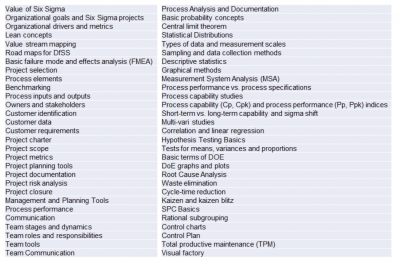
SSBOK is a list of topics which cover the training and certification for Six Sigma White Belts, Yellow Belts, Green Belts (GB), Black Belts (BB), and Master Black Belts. The topics in the SSBOK will follow the DMAIC structure. This article will review some of the topics typically found in the SSBOK, the benefits of SSBOK, and some cautions since there is no universally accepted SSBOK.
Overview: What is SSBOK?
SSBOK is a collection of Six Sigma topics that serve as the minimum knowledge base for training and certifying the various Belt designations.
While there is no single professional organization recognized as the sole source of the SSBOK, the American Society of Quality (ASQ) is widely recognized and used as a template and benchmark for many companies.
Let’s look at the list of topics for the ASQ Green and Black Belt SSBOK. Here is the GB SSBOK:

Here is the BB SSBOK:

3 benefits of SSBOK
An agreed-upon body of knowledge will have the following benefits.
1. Consistent teaching
Using a SSBOK to develop Six Sigma training curriculum would provide a consistent set of topics and content for teaching purposes.
2. Minimum required knowledge
A SSBOK allows for the determination of the minimum levels of knowledge required for certification.
3. Professional standards
For Six Sigma professionals, having a common SSBOK provides assurance the certified Belt you are hiring has shown a level of mastery consistent with the minimum requirements to be certified.
Why is SSBOK important to understand?
Having a source of what the industry believes is the required knowledge to be a Six Sigma professional is important to understand.
Captures basic knowledge
Most SSBOK variations all capture similar basic concepts and tools. The list will be sufficient, but not exhaustive.
Guide for training
Once you’ve identified a SSBOK you’re comfortable with, be sure you design your training materials to be consistent with it.
No single source of SSBOK
There are numerous organizations claiming to have the SSBOK. Be careful in your selection should you choose to use their SSBOK to train your people.
An industry example of SSBOK
After providing Lean Six Sigma training for a large pharmaceutical company, the consultant they hired was questioned about whether his GB and BB training was consistent with the ASQ SSBOK.
To satisfy the client’s inquiry, he did a one-to-one comparison of his training materials with the ASQ SSBOK. Below is an excerpt from the comparison of GB and BB.


After reviewing the comparison, the client was satisfied that the training her company was getting was consistent with the ASQ SSBOK and, in some cases, more extensive.
3 best practices when thinking about SSBOK
It is best to try and emulate and model your Six Sigma training against one of the more widely accepted SSBOK rather than start from scratch.
1. Compare your training with the SSBOK
For your company’s Six Sigma certification to be credible, be sure your training is comparable to one of the more accepted SSBOK topical outlines.
2. Testing and certification baseline
There is significant variation in what is taught, tested, and certified in the field of Six Sigma. An accepted SSBOK will provide a good baseline for you to use as a benchmark for your Six Sigma deployment.
3. Create composite SSBOK
Since there is no singular accepted SSBOK, it will be useful for you to evaluate the most popular and try to create a composite SSBOK for your organization.
Frequently Asked Questions (FAQ) about SSBOK
Is there a SSBOK for all Six Sigma Belt levels?
Most organizations professing to have a SSBOK will include topics for White, Yellow, Green, Black, and Master Black Belts.
Is there one source for the SSBOK?
No, there are many organizations providing Six Sigma training that use their own SSBOK to train and certify Six Sigma belts.
What is the main advantage of having a SSBOK?
It can provide a consistent set of knowledge, expectations, and mastery requirements for persons seeking training and certification in Six Sigma.
Is there a difference between training and certification?
Yes. You will find some organizations who provide Six Sigma training either externally or internally. The culmination of training is an exam. Certification comes after the completion of a Six Sigma project(s). These two activities can be provided by third-party organizations or by the company itself.
Wrapping up SSBOK
SSBOK is a comprehensive list of Six Sigma topics to be used for training Belts and demonstrating knowledge, proficiency, and mastery of Six Sigma. There is no globally recognized organization with the consummate SSBOK. It is recommended you do some research to identify the most accepted and credible group, and use their SSBOK as a benchmark.